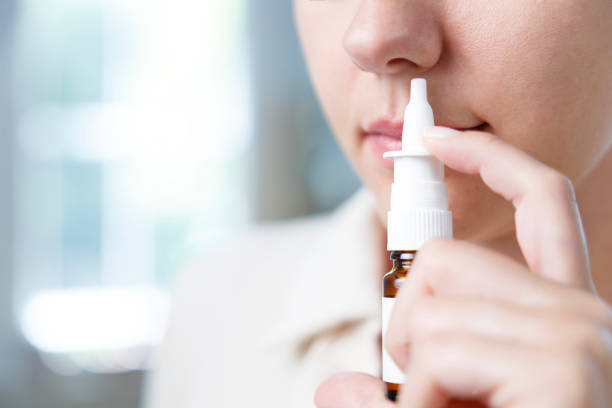USP Inhalation Solution Endotoxin Testing
The USP Inhalation Solution Endotoxin Test is a critical procedure designed to evaluate the presence of endotoxins in solutions intended for inhalation, including nasal products. This test ensures that any pharmaceutical product entering the lungs or nasal passages meets stringent safety standards set by regulatory bodies like the United States Pharmacopeia (USP). The primary focus of this testing is to identify potential contaminants that could cause adverse reactions in patients.
Endotoxins are a component of Gram-negative bacteria and can trigger inflammatory responses. Inhalation products, particularly those targeting the respiratory tract, must be free from these potentially harmful substances to maintain patient safety. This test is especially important for nasal sprays, nebulizers, and other delivery systems that bypass the gastrointestinal tract, thus avoiding natural detoxification mechanisms.
The USP 85 section provides detailed guidance on conducting this test using a quantitative chromogenic method with Limulus amebocyte lysate (LAL). The LAL reagent reacts specifically to endotoxins present in the solution, allowing for precise quantification. This approach ensures that even trace amounts of contaminants are detected.
The testing process involves several key steps:
- Preparation of the sample solution according to USP specifications.
- Injection of the sample into the LAL reagent.
- Observation and measurement of the reagent’s color change, which indicates endotoxin levels.
- Calculation of the endotoxin concentration based on standard curves generated from known concentrations of endotoxins.
The USP guidelines are widely recognized in the pharmaceutical industry. Compliance with these standards is crucial for ensuring product quality and safety, which directly translates to patient trust and regulatory approval.
Inhalation solutions often face additional challenges due to their complex formulation and delivery mechanisms. The endotoxin test is essential in addressing these issues by providing a reliable measure of contamination risk. This ensures that the final product is safe for patients, especially those with compromised immune systems or respiratory conditions.
International Acceptance and Recognition
The USP Inhalation Solution Endotoxin Test enjoys international recognition and acceptance, particularly in countries where USP standards are adopted. This includes not only the United States but also regions like Europe, Australia, and parts of Asia.
The test aligns with ISO 14310:2019, which provides additional context for endotoxin testing in pharmaceutical products. The international standard emphasizes the importance of consistent methodology across different laboratories to ensure accurate and reliable results. This alignment enhances confidence among healthcare providers and regulatory agencies worldwide.
Compliance with these standards is not merely a legal requirement but also a demonstration of commitment to patient safety and product quality. Laboratories that perform this test must adhere strictly to established protocols, ensuring the accuracy and consistency of their results.
The widespread acceptance of USP testing in inhalation solutions highlights its significance in maintaining global pharmaceutical standards. This recognition underscores the importance of rigorous testing procedures in safeguarding public health.
Competitive Advantage and Market Impact
Pharmaceutical companies that invest in robust endotoxin testing programs gain a significant competitive edge by ensuring their products meet or exceed stringent quality standards. In the highly regulated pharmaceutical market, compliance with USP guidelines is essential for product approval and marketing.
The ability to consistently deliver safe inhalation solutions can enhance brand reputation and foster consumer trust. This trust is crucial in maintaining customer loyalty and expanding market share. Hospitals, clinics, and pharmacies that use these products are more likely to recommend them due to their proven safety profile.
Moreover, compliance with international standards like ISO 14310 positions companies as leaders in product quality and patient safety. This leadership can open doors to new markets and partnerships, thereby enhancing overall market impact.
The endotoxin test also plays a crucial role in risk management within the pharmaceutical industry. By identifying potential contaminants early in the production process, companies can mitigate risks associated with product recalls or lawsuits due to adverse reactions. This proactive approach not only protects the company’s reputation but also reduces financial losses.
Use Cases and Application Examples
| Product Type | Description of Product | Testing Criteria | Expected Outcome |
|---|---|---|---|
| Nasal Spray | A solution designed to relieve nasal congestion. | Endotoxin levels must not exceed 0.25 EU/mL. | The product passes endotoxin testing, ensuring safe and effective use. |
| Inhaler Solution | An aerosolized medication for asthma management. | No detectable endotoxins in the solution. | The inhalation solution is free from contaminants that could exacerbate respiratory conditions. |
| Nebulizer Fluid | A liquid formulation for use with nebulizers to treat chronic obstructive pulmonary disease (COPD). | Endotoxin levels must be less than 0.1 EU/mL. | The nebulizer fluid meets safety standards, ensuring patient safety during treatment. |
Inhalation solutions are diverse and serve various medical needs. The USP endotoxin test is applicable to a wide range of products including nasal sprays, inhalers, nebulizers, and other aerosolized medications. Each product type has specific testing criteria designed to ensure patient safety.
The expected outcome of passing the endotoxin test is that the product meets or exceeds regulatory standards for endotoxin content. This ensures that patients receive safe and effective treatments without the risk of adverse reactions due to bacterial contamination.





